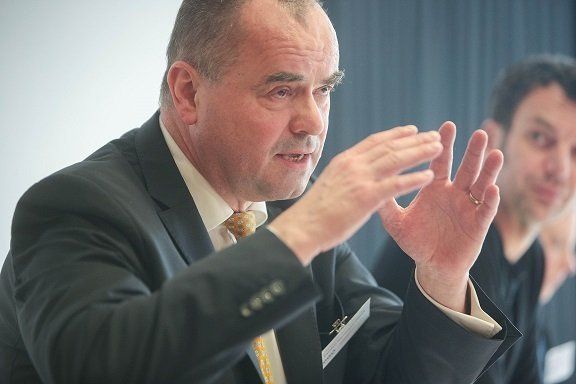Institutions and naturalism
The expression ‘a naturalistic theory of institutions’ has two meanings, which both count with equal weight. Firstly, if we want to understand why humans follow institutions, we need to adopt a transdisciplinary approach, merging sociology, ethics and other fields of the social sciences and humanities with psychology, biology and cognitive sciences. Secondly, we approach institutions as ‘real world entities’, which means we give them equal ontological status like rocks, water or bees. However, this is only the first step in exploring Hegel’s famous notion of ‘second nature’ as applied on institutions.
Hegel and Searle
Naturalism accepts the basic fact of ‘physical closure’ of the world, but at the same time distinguishes, following John Searle, between two different kinds of worldly facts, observer relative and observer independent. Institutions are observer relative facts. This is a Hegelian position, and indeed Searle, in his most recent version of his theory, talks of ‘mind’ instead of ‘observer’. I reject this and keep the ‘observer’, because institutions are part and parcel of the mind, or ‘spirit’, in Hegelian parlance. ‘Observers’, in my theory, can be all kinds of physical entities, such as animals, or even autocatalytic chemical processes. Institutions are special kinds of observer relative facts that are specific to human observers. I would say, that this is indeed a defining feature of humans in the ‘tree of life’: We are the ‘institutional animals’.
Before my 'Hegelian turn', I developed a naturalistic approach to performativity in which this basic point was firstly established:
The Aoki model
If institutions are real world entities, we can approach them in terms of physical causalities, in one perspective. In my work, I rely on Aoki’s game theoretic approach to institutions to clarify this causality (see the diagram). The basic point is that institutions involve population-level interactions, which we can analyse via game theory, both strategic and evolutionary, and individual-level mediating mechanisms, which we can analyse via cognitive science, psychology or biology. Between the levels, there are two causal channels which represent the major deviations from standard economics approaches to institutions. Firstly, as Aoki elaborates in much detail, institutions connect with individual behaviour via the information-compression function of public representations (which I call ‘signs’, hence refer to as semiosis). This function channels behaviour towards a certain direction. Since representations are public, perceptions are partly shared among the members of a population. This results into what Searle or Tuomela call ‘collective intentionality’ in following an institution, in a nutshell, meaning that ‘we’ follow, and not just a number of ‘I’s. In my extensions of the Aoki model, I call the first causal channel the ‘distributed cognition’ function and the second one the ‘performativity’ function. This results into properties of institutions that are very similar to language, and thus are non-physical, according to the traditional understanding. For more on this, see my JEM paper:
download paper
Performativity
In our work on Hegel, Ivan Boldyrev and I interpret Hegel’s ‘second nature’ idea in terms of the three principles of ‘continuity’, ‘performativity’ and ‘recognition’. With reference to the Aoki model, ‘continuity’ means that following an institution is anchored in psychological and biological mechanisms, such as emotions and certain cognitive structures, ultimately embodied in the neurophysiological architecture of the brain. ‘Performativity’ results from the interaction of semiosis and collective intentionality, thus manifests the ‘cultural nature’ of institutions. ‘Recognition’ means that collective intentionality requires mutual recognition of individuals in following an institution.
In my own work, I have chosen money as one of the primordial economic institutions to demonstrate the validity of this approach. In the case of money, most economists would agree that it builds on recognition and that it is performative, that is, there is no such thing as a ‘natural money’. Money is purely artificial, yet it becomes part and parcel of human nature, as recent research in psychology has shown in considerable detail. Money interacts with emotions and cognition, it changes our valuations and behaviour, and it enables our economic rationality. This naturalistic and evolutionary approach to money has been explored in a 2014 paper published in the Jahrbücher für Nationalökonomie and Statistik:
download paper
In my own work, I have chosen money as one of the primordial economic institutions to demonstrate the validity of this approach. In the case of money, most economists would agree that it builds on recognition and that it is performative, that is, there is no such thing as a ‘natural money’. Money is purely artificial, yet it becomes part and parcel of human nature, as recent research in psychology has shown in considerable detail. Money interacts with emotions and cognition, it changes our valuations and behaviour, and it enables our economic rationality. This naturalistic and evolutionary approach to money has been explored in a 2014 paper published in the Jahrbücher für Nationalökonomie and Statistik:
Money
Only recently I realized that the great German sociologists Georg Simmel anticipated much of this. However, today we are able to elaborate on his ideas in much more scientific detail, including the biological foundations of the money institution and the more specific cognitive and emotional mechanisms that undergird the use of money in society.
I argue that the way how we establish and make use of the money institution in our society is an important element of how we ‘perform’ our entire economic system and political economy. Thinking of the so-called ‘neoliberal’ turn of the 1980s, that was in fact a move towards ‘financial capitalism’ in which the money institution plays a different role than, for example, in ‘Rhenish capitalism’. Even economists often underestimate the essential role of accounting methods, incentive schemes and so forth in determining the ways how economic systems work.
For my analysis of financial capitalism, see my 2013 JEM paper:
